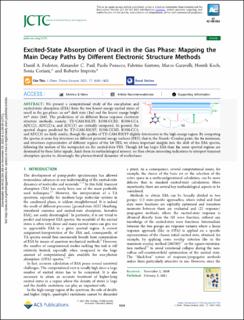| dc.contributor.author | Fedotov, Daniil | |
| dc.contributor.author | Paul, Alexander Christian | |
| dc.contributor.author | Posocco, Paolo | |
| dc.contributor.author | Santoro, Fabrizio | |
| dc.contributor.author | Garavelli, Marco | |
| dc.contributor.author | Koch, Henrik | |
| dc.contributor.author | Coriani, Sonia | |
| dc.contributor.author | Improta, Roberto | |
| dc.date.accessioned | 2023-11-29T11:13:07Z | |
| dc.date.available | 2023-11-29T11:13:07Z | |
| dc.date.created | 2021-01-07T22:17:59Z | |
| dc.date.issued | 2021 | |
| dc.identifier.citation | Journal of Chemical Theory and Computation. 2021, 17 (3), 1638-1652. | en_US |
| dc.identifier.issn | 1549-9618 | |
| dc.identifier.uri | https://hdl.handle.net/11250/3105200 | |
| dc.description.abstract | We present a computational study of the one-photon and excited-state absorption (ESA) from the two lowest energy excited states of uracil in the gas phase: an nπ* dark state (1n) and the lowest energy bright ππ* state (1π). The predictions of six different linear response electronic structure methods, namely, TD-CAM-B3LYP, EOM-CCSD, EOM-CC3, ADC(2), ADC(2)-x, and ADC(3) are critically compared. In general, the spectral shapes predicted by TD-CAM-B3LYP, EOM-CCSD, EOM-CC3, and ADC(3) are fairly similar, though the quality of TD-CAM-B3LYP slightly deteriorates in the high-energy region. By computing the spectra at some key structures on different potential energy surfaces (PES), that is, the Franck–Condon point, the 1n minimum, and structures representative of different regions of the 1π PES, we obtain important insights into the shift of the ESA spectra, following the motion of the wavepacket on the excited-state PES. Though 1π has larger ESA than 1n, some spectral regions are dominated by these latter signals. Aside from its methodological interest, we thus obtain interesting indications to interpret transient absorption spectra to disentangle the photoactivated dynamics of nucleobases. | en_US |
| dc.language.iso | eng | en_US |
| dc.publisher | ACS Publications | en_US |
| dc.relation.uri | https://doi.org/10.26434/chemrxiv.13176554.v1 | |
| dc.rights | Attribution-NonCommercial-NoDerivatives 4.0 Internasjonal | * |
| dc.rights.uri | http://creativecommons.org/licenses/by-nc-nd/4.0/deed.no | * |
| dc.title | Excited State Absorption of Uracil in the Gas Phase: Mapping the Main Decay Paths by Different Electronic Structure Methods | en_US |
| dc.title.alternative | Excited State Absorption of Uracil in the Gas Phase: Mapping the Main Decay Paths by Different Electronic Structure Methods | en_US |
| dc.type | Peer reviewed | en_US |
| dc.type | Journal article | en_US |
| dc.description.version | publishedVersion | en_US |
| dc.source.pagenumber | 1638-1652 | en_US |
| dc.source.volume | 17 | en_US |
| dc.source.journal | Journal of Chemical Theory and Computation | en_US |
| dc.source.issue | 3 | en_US |
| dc.identifier.doi | 10.1021/acs.jctc.0c01150 | |
| dc.identifier.cristin | 1867416 | |
| dc.relation.project | Sigma2: NN2962K | en_US |
| dc.relation.project | EC/H2020/EC/H2020 765739 | en_US |
| dc.relation.project | Norges forskningsråd: Research Council of Norway (RCN) 275506 | en_US |
| dc.relation.project | Norges forskningsråd: Research Council of Norway (RCN) 263110 | en_US |
| cristin.ispublished | true | |
| cristin.fulltext | postprint | |
| cristin.qualitycode | 2 | |

